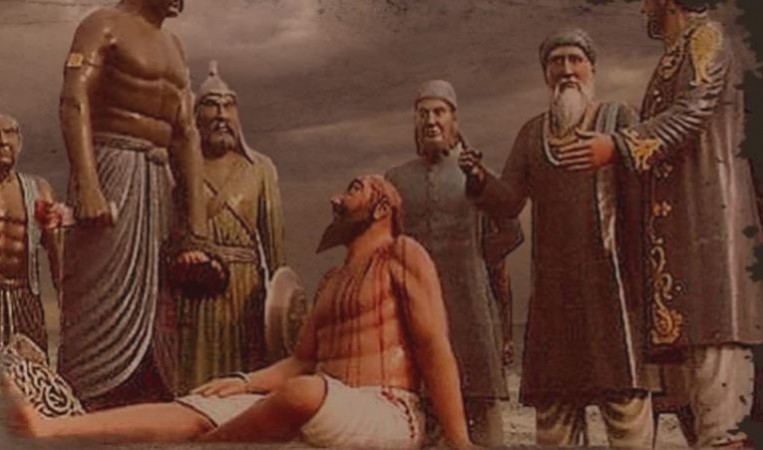
The son of Shaheed Bhai Jodh Singh and Bibi Dharam Kaur of the Sandhu Jatt family of Poohla village in the Punjab's Amritsar area, Bhai Taru Singh, a Sikh martyr, lived from October 6, 1720, to July 1, 1745. Bibi Tar Kaur was the name of his younger sister. He was a devout Sikh who upheld the teachings of the Sikh Gurus, toiled his land carefully, and lived simply. Despite not being wealthy, he was always joyful and did much for his Sikh brothers and sisters despite his lack of wealth.
His Sikh comrades who were driven into exile due to government persecution received anything he could spare. Following Akil Das of Jandiala's spying on him (also known as Harbhagat Niranjania, a government informant), Taru Singh was brought before Zakariya Khan, the governor of Punjab who was located in Lahore.
Also read: Bota Singh And Garaja Singh: Two Tigers
Bhai Taru Singh was reared as a Sikh by his widowed mother, Bibi Dharam Kaur, after his father, Bhai Jodh Singh, had perished in war when he was born during the reign of the Mughal Empire in Punjab. Sikh revolutionaries had fled to the bush during this time and were preparing to overthrow the Khan. These Sikh soldiers received food and other assistance from Bhai Taru Singh and his sister Tar kaur (Taro) Kaur. The two of them were detained for treason when Zakaria Khan told Akil Das about them to the authorities. Even when the villagers paid for his sister's freedom, Bhai Taru Singh declined to ask for forgiveness.
Zakariya Khan once questioned his warriors, "Where do the Sikhs obtain their nourishment?," according to the Prachin Panth Prakash's narration of the incident. They are no longer allowed to work in any capacity. They don't see any taxes. They are not permitted to engage in farming, business, or employment in the public sector. All donations to their gurdwaras, or places of worship, have been halted by me. They cannot obtain any supplies or resources. Why do they not simply starve to death?
Also read: Sardaar Baaj Singh Bandai: Fearlessness in Battle
There are Sikhs in this world who would not eat until they had nourished their compatriots, said Harbhagat, a sworn enemy of the Sikhs. They may do without food and clothing themselves, but they are unable to tolerate their friends' suffering. They would stay warm during the winter by the fire, sending them their own clothing. They would work themselves thin to grind maize and get it delivered. To earn a meagre income for themselves, they would perform the most difficult tasks. To help their brothers who are in exile, they move to far-off areas.
One Taru Singh resides in the Majha village in Puhia, said Harbhagat. He cultivates his land and pays the authorities from the proceeds. He consumes very little food and sends what is left over to his jungle-dwelling brothers. His mother and sister both work hard and struggle to make ends meet. They consume little food and dress in the roughest home spun. They give their fellow Sikhs anything they have saved.
After Akil Das' report, Bhai Taru Singh was detained, tortured, and imprisoned. Finally, when he was brought before the governor, he brazenly saluted him with Vahiguru ji ka Khalsa, Vahiguru ji ki Fateh, the Sikh salutation.
Also read: Oldest Gurudwara’s: Most spiritual places
His execution's precise method is not entirely clear. The consensus is that Singh was brought before the Khan and offered the option of converting to Islam or being put to death after only a brief time of detention and torture. Singh would have to remove his Kesh and offer it to the Khan as a sign of his conversion. Bhai Taru Singh was forced to have his scalp severed from his head after refusing, and it was done in front of everyone to stop his hair from ever coming back. It is thought that this cruel deed was committed on June 9th, 1745.
Zakaria Khan allegedly suffered from excruciating discomfort and the inability to urinate after Bhai sahib was sent back to the prison to die slowly, according to Sikh tradition. When he asked his advisors about this unexpected illness, they informed him that the Sikhs' mistreatment was to blame. He addressed an apology to the Khalsa Panth for his persecution of the Sikhs and pleaded for their pardon because to the excruciating anguish and as a last resort.
Also read: Gurudwara of Delhi: Unique History
His advisors believed that Zakaria Khan might be cured if he used Bhai Taru Singh's shoes to strike his own scalp. Despite the shoe curing the Khan's illness, he passed away 22 days later. On the first of July 1745, Bhai Taru Singh departed for Sachkhand after learning that he had miraculously outlived the Khan.
At the time, Taru Singh was just 25 years old. His body was burned to death in front of Lahore's Delhi Gate, where a shrine to martyrs called "Shahidganj" was later built. For the Sikhs, it became a place of pilgrimage.
Also read: Indore’s Historic Gurudwara